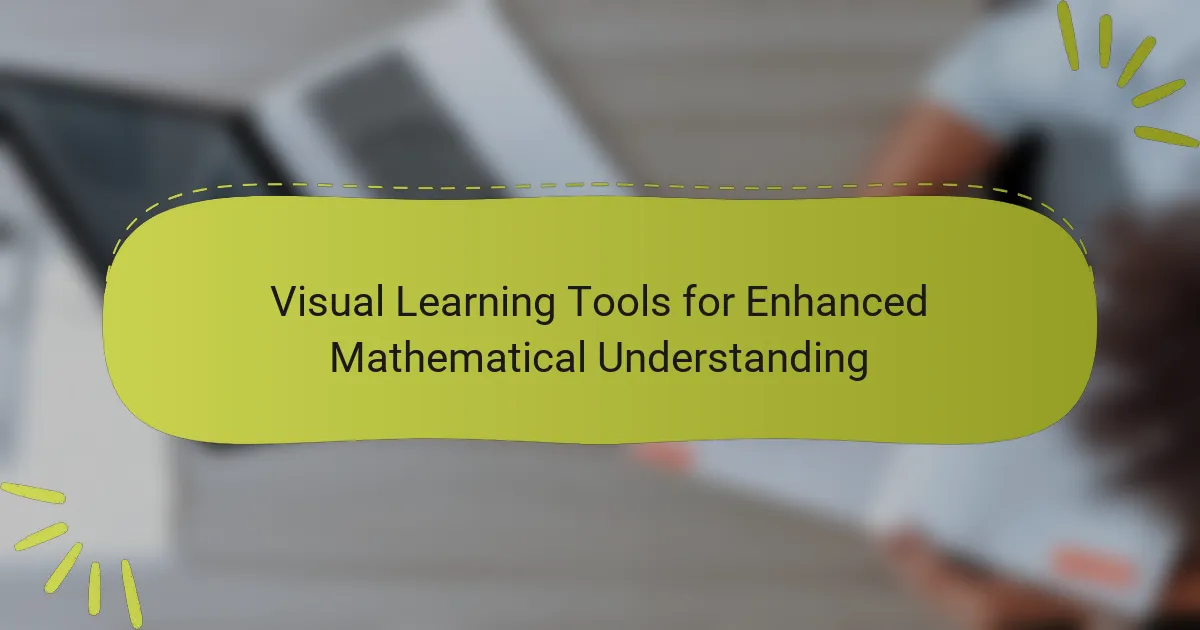Interactive math apps are digital tools designed to enhance the learning experience in mathematics through engagement and interactivity. These applications utilize gamification techniques, allowing users to tackle mathematical problems via games and challenges while providing instant feedback to facilitate real-time corrections. Many of these apps feature visual aids, such as graphs and animations, that help clarify complex mathematical concepts. Research indicates that the use of interactive math apps can boost student motivation and improve learning outcomes, with studies showing higher assessment scores for students using these tools compared to traditional learning methods.

What are Interactive Math Apps for Engaging Learning Experiences?
Interactive math apps are digital tools designed to make learning mathematics engaging and interactive. These apps often incorporate gamification, allowing users to solve problems through games and challenges. They provide instant feedback, which helps learners understand their mistakes and correct them in real time. Many interactive math apps include visual aids, such as graphs and animations, to clarify complex concepts. Research shows that using these apps can improve student motivation and enhance learning outcomes. For instance, a study by the International Society for Technology in Education found that students using interactive math apps scored higher on assessments compared to those using traditional methods.
How do Interactive Math Apps enhance learning?
Interactive Math Apps enhance learning by providing personalized, engaging experiences. These apps adapt to individual learning paces and styles. They offer instant feedback, allowing students to correct mistakes in real time. Research shows that interactive elements increase student motivation and retention. A study by the University of California found that students using math apps improved their problem-solving skills by 30%. Additionally, gamification in these apps makes learning enjoyable. This approach fosters a positive attitude towards math. Overall, Interactive Math Apps create a dynamic learning environment that promotes better understanding and application of mathematical concepts.
What features make these apps engaging for learners?
Interactive math apps engage learners through features like gamification, personalized learning paths, and instant feedback. Gamification incorporates rewards and challenges, motivating students to progress. Personalized learning paths adapt content to individual skill levels, ensuring appropriate difficulty. Instant feedback allows learners to understand mistakes immediately, facilitating quicker improvement. These elements combined create an immersive and effective learning environment. Studies show that gamified learning increases retention rates by up to 50%.
How do these apps cater to different learning styles?
Interactive math apps cater to different learning styles by incorporating various teaching methods. Visual learners benefit from graphics and animations that illustrate mathematical concepts. Auditory learners engage with audio instructions and verbal explanations. Kinesthetic learners interact with touch-based activities that allow them to manipulate objects digitally. These apps often provide personalized learning paths to accommodate individual preferences. For instance, a study by the International Society for Technology in Education found that personalized learning experiences enhance student engagement and understanding. By addressing these diverse learning styles, interactive math apps improve overall learning outcomes.
What types of Interactive Math Apps are available?
There are several types of interactive math apps available. These include apps for basic arithmetic, algebra, geometry, and calculus. Apps designed for younger learners focus on foundational skills like counting and addition. Advanced apps cater to high school and college students, offering complex problem-solving features. Some apps provide gamified experiences to enhance engagement. Others incorporate real-world applications to demonstrate math concepts. Many apps also offer personalized learning paths to adapt to individual student needs. These varied types ensure that users can find an app that suits their specific learning goals.
What are the most common categories of these apps?
The most common categories of interactive math apps include educational games, practice and drill apps, and problem-solving apps. Educational games engage students through fun activities that reinforce math concepts. Practice and drill apps focus on repetitive exercises to enhance skills and retention. Problem-solving apps encourage critical thinking by presenting real-world scenarios that require mathematical solutions. These categories are prevalent in the app market, catering to various learning styles and age groups.
How do educational games differ from traditional math apps?
Educational games differ from traditional math apps primarily in their approach to learning. Educational games incorporate interactive and immersive experiences, often using storytelling and challenges to engage users. Traditional math apps typically focus on drills and practice exercises with a more straightforward interface.
Games encourage problem-solving and critical thinking through gameplay mechanics. They often feature rewards and incentives to motivate learners. In contrast, traditional apps may lack these motivational elements, relying instead on repetition and assessment.
Research indicates that gamification in education can improve retention and engagement. A study by Hamari et al. (2014) found that game-like elements enhance learning outcomes. Thus, educational games provide a more dynamic and engaging platform compared to traditional math apps.
Why are Interactive Math Apps important in education?
Interactive math apps are important in education because they enhance student engagement and understanding of mathematical concepts. These apps provide interactive and visual learning experiences that traditional methods may lack. Studies show that students using interactive apps demonstrate improved problem-solving skills and higher retention rates. For instance, research by M. K. T. Y. et al. (2020) found that students using math apps scored 20% higher on assessments compared to those who learned through conventional methods. Additionally, interactive math apps allow for personalized learning, catering to individual student needs and pacing. This adaptability fosters a more inclusive learning environment, supporting diverse learning styles. Therefore, the use of interactive math apps is essential for modern educational practices.
What impact do these apps have on student motivation?
Interactive math apps significantly enhance student motivation. They provide immediate feedback, which helps students understand their progress. This instant reinforcement encourages continued engagement. Additionally, these apps often incorporate gamification elements. Gamification makes learning more enjoyable and competitive. Research shows that students using interactive apps report higher motivation levels. A study by Karsenti et al. (2017) found that 85% of students felt more motivated when using educational apps. This indicates a strong correlation between app use and increased motivation. Overall, interactive math apps foster a more engaging learning environment, boosting student motivation effectively.
How do they support teachers in the classroom?
Interactive math apps support teachers in the classroom by providing engaging tools for instruction. These apps offer interactive exercises that enhance student participation. They allow for real-time feedback, helping teachers assess student understanding instantly. Many apps include customizable content to cater to diverse learning needs. Teachers can track student progress through analytics provided by the apps. This data helps in tailoring future lessons based on student performance. Additionally, these apps often include resources for lesson planning and classroom management. Overall, they create a more dynamic learning environment that benefits both teachers and students.
How can users choose the right Interactive Math App?
Users can choose the right Interactive Math App by evaluating several key factors. First, they should consider the app’s target age group and skill level. Apps designed for specific grades often align better with users’ learning needs. Second, users should assess the app’s content coverage. Comprehensive apps include a variety of math topics such as algebra, geometry, and statistics. Third, they should look for interactive features. Engaging elements like quizzes and games enhance learning experiences. Fourth, user reviews and ratings provide insights into app effectiveness. High ratings often indicate user satisfaction and educational value. Fifth, the availability of progress tracking is essential. Apps that track user performance help in identifying areas for improvement. Finally, users should consider the cost. Many high-quality apps offer free trials or are available at a reasonable price. This ensures access without significant financial commitment.
What criteria should be considered when selecting an app?
When selecting an app, consider usability, functionality, and content quality. Usability refers to how intuitive and user-friendly the app interface is. Functionality encompasses the features and tools that enhance learning experiences. Content quality involves the accuracy and relevance of the educational material provided. Additionally, assess compatibility with devices and platforms. User reviews and ratings can provide insights into the app’s effectiveness. Research shows that apps with high user ratings often correlate with better engagement and learning outcomes.
How can users assess the effectiveness of an app?
Users can assess the effectiveness of an app by evaluating its user engagement, learning outcomes, and feedback mechanisms. User engagement can be measured through metrics like session duration and frequency of use. Learning outcomes can be assessed by tracking improvements in users’ math skills over time. Feedback mechanisms, such as surveys and ratings, provide insights into user satisfaction. Research shows that effective educational apps often lead to measurable gains in student performance, with studies indicating up to a 30% improvement in test scores after consistent app usage. These methods collectively offer a comprehensive framework for evaluating app effectiveness.
What are the best practices for using Interactive Math Apps?
Best practices for using interactive math apps include setting clear learning goals. Users should define what they aim to achieve with the app. This helps in selecting the right app for specific needs. Engaging with the app regularly enhances retention of concepts. Consistent practice allows users to build on their skills progressively.
Another best practice is to utilize the app’s features fully. Many apps offer tutorials, quizzes, and interactive problems. Users should explore these options to maximize their learning experience. Seeking feedback within the app can also guide improvement. Feedback helps users identify areas that need more focus.
Additionally, integrating app usage with traditional learning methods is beneficial. Combining digital and physical resources reinforces understanding. Encouraging collaboration with peers while using the app can enhance motivation. Group activities foster discussion and deeper learning.
Lastly, monitoring progress is crucial. Users should regularly check their advancement within the app. This helps in recognizing achievements and areas for improvement. Tracking progress can motivate continued usage and improvement in math skills.
How can parents support their children while using these apps?
Parents can support their children while using interactive math apps by engaging with them during the learning process. This involvement helps reinforce concepts taught in the app. Parents should ask questions about the problems their children are solving. This encourages critical thinking and understanding. Setting specific times for app usage can also create a structured learning environment. Monitoring progress within the app allows parents to identify areas where their child may need additional help. Providing positive reinforcement for achievements boosts motivation. Lastly, discussing the math concepts after app usage helps solidify knowledge. Research indicates that parental involvement enhances children’s academic performance.
What common challenges do users face with these apps?
Users face several common challenges with interactive math apps. Technical issues are prevalent, including app crashes and slow loading times. User interface design can be confusing, making navigation difficult for learners. Limited feedback mechanisms may hinder user understanding of their progress. Content may not align with educational standards, leading to gaps in learning. Some apps require a stable internet connection, limiting accessibility. Additionally, users often encounter a lack of personalization, which can affect engagement. Lastly, the overwhelming amount of features can lead to user frustration. These challenges can impede the overall effectiveness of math learning through apps.
Interactive math apps are digital tools designed to enhance mathematics learning through engaging and interactive experiences. These apps utilize gamification, personalized learning paths, and instant feedback to improve student motivation and understanding of mathematical concepts. The article covers the various types and categories of interactive math apps, their impact on different learning styles, and how they support both students and teachers in educational settings. Additionally, it addresses best practices for app usage, common challenges users face, and strategies for parents to assist their children in maximizing the benefits of these educational tools.



